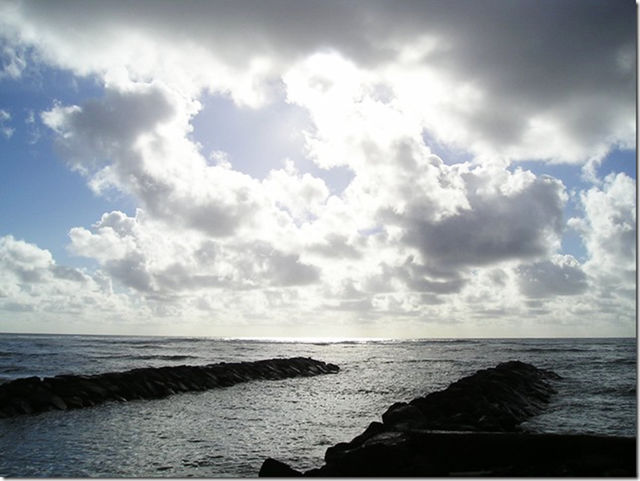September has reigned upon the island with some serious storm warnings, sharply slanted sunshine, billowing clouds trailing delicate veils and and bird wing patterns troweled across powder blue skies on fair days. Many people I’ve met when out and about
September has reigned upon the island with some serious storm warnings, sharply slanted sunshine, billowing clouds trailing delicate veils and and bird wing patterns troweled across powder blue skies on fair days. Many people I’ve met when out and about on sunny days — some of them friends, some complete strangers — have said, “Isn’t it a beautiful day? Could it be more perfect?” The only answer is in the affirmative, along with an exchange of smiles.
Last week while stretching to exercise in a wellness therapy clinic I’m attending, a young stranger asked, “Did you see the sunrise today?” He went on to remark how awesome it was.
Now “awesome” is an overused word today, being commonly applied to the most everyday events and achievements of young and old alike, which has become a pet peeve for me. However, I took this use of “awe-some” in the full context of what this young man was moved to describe of the reverential wonder and magnificence with which his sighting of the rising sun had gifted him.
It was the week of the autumn equinox, when for three days in Hawaii, the sun may be viewed as if it is rising in the same exact spot on the eastern horizon. This brings to mind the Hawaiian cultural heiau, or sacred space at the south side of Wailua Bay marking Hikina a ka La (“to the East rises the Sun”).
There is an oli, a chant by Pualani Kanaka‘ole Kanahele, that was composed to greet the dawning of the day. In a prayerful and poetic way, this oli written in the old style contains the science gained by observational practices and the cultural awe and reverence that the first settlers of this island felt and practiced. The ancestors left us the valuable “book” in remaining archaeological treasures of stones that delineate sacred space and the careful naming of such places in a metaphoric language.
Oli (Chant) to the Rising of the Sun
— Pualani Kanaka‘ole Kanahele
E ala e! Awake!
Ka la i ka hikina O sun in the east
I ka moana From the deep
Ka moana hohonu From the life in the ocean
Pi‘i i ka lewa Climb to the heights
Ka lewa nu‘u To the sky above
I ka hikina In the east
Aia ka la There is the sun
E ala e! (Repeat three times) Awake!
Now, to moon talk. Actually, based on the Hawaiian moon calendar, the new lunar month — Hilinama (also, Mahoehope, to some) — began Sept. 2 and will close on the first midnight of October. The moons of Sept. 19-21 marked the transitional marker of the Piko o Wakea (Umbilical of Wakea).
This is a signal to the people of the land that the heat of summer will now wane and the days will grow gradually shorter; the length of night will prevail as daylight hours grow shorter. As with the equinox, the transition marks when nox (L. night), equals day in length.
According to traditional knowledge (and according to my observation), this is the time that the ulu (breadfruit) is increasing in size, lilikoi (passion fruit) vines start flowering along with well-hidden, multi-tiered olena (turmeric) blooms.
Returning kolea (Golden Plovers) have been sighted. If you like finding hee, or octopus to prepare (as do our neighbors, who run them through a wash cycle to soften them up), the time will be right for gathering such delicacy. Also, in our garden, starfruit is ready to harvest and enjoy, and abundant young citrus fruits are soaking up sun and water until turn-of-the-year harvest.
If you are one who likes observing and recording your findings, you might enjoy becoming the kilo, observer and information gatherer, for yourself and maybe your family and friends.
In the ancestral times of the Polynesians who became Hawaiians, this led to being a predictor of natural events as the annual repetitiveness of patterns was noted. There are observation journals and logs available online.
You may also find and print a simple observation sheet on which to record your findings from moon location and shape through plants, weather, ocean conditions, what you notice of birds, fish and insects, as well as the people around you at http://www.aimalama.org/resources.
•••
Dawn Fraser Kawahara, author and poet, has for many years instructed on the topics of history and Hawaiian culture for visitors to Kauai through Elderhostel and Road Scholar programs. The writer is completing her second memoir, based on her youthful experience living in the Burma of post-World War II times and recent travels back to her family’s old home. Her books, including “Behold Kauai — Modern Days, Ancient Ways,” may be found in local outlets and libraries and are also available through Amazon.


